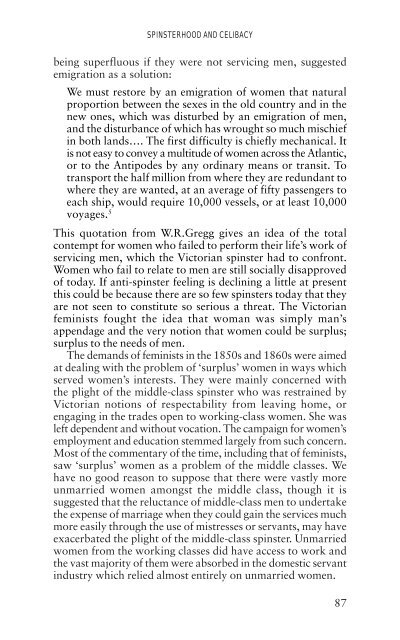The Spinster and Her Enemies - Feminish
The Spinster and Her Enemies - Feminish
The Spinster and Her Enemies - Feminish
You also want an ePaper? Increase the reach of your titles
YUMPU automatically turns print PDFs into web optimized ePapers that Google loves.
SPINSTERHOOD AND CELIBACY<br />
being superfluous if they were not servicing men, suggested<br />
emigration as a solution:<br />
We must restore by an emigration of women that natural<br />
proportion between the sexes in the old country <strong>and</strong> in the<br />
new ones, which was disturbed by an emigration of men,<br />
<strong>and</strong> the disturbance of which has wrought so much mischief<br />
in both l<strong>and</strong>s…. <strong>The</strong> first difficulty is chiefly mechanical. It<br />
is not easy to convey a multitude of women across the Atlantic,<br />
or to the Antipodes by any ordinary means or transit. To<br />
transport the half million from where they are redundant to<br />
where they are wanted, at an average of fifty passengers to<br />
each ship, would require 10,000 vessels, or at least 10,000<br />
voyages. 5<br />
This quotation from W.R.Gregg gives an idea of the total<br />
contempt for women who failed to perform their life’s work of<br />
servicing men, which the Victorian spinster had to confront.<br />
Women who fail to relate to men are still socially disapproved<br />
of today. If anti-spinster feeling is declining a little at present<br />
this could be because there are so few spinsters today that they<br />
are not seen to constitute so serious a threat. <strong>The</strong> Victorian<br />
feminists fought the idea that woman was simply man’s<br />
appendage <strong>and</strong> the very notion that women could be surplus;<br />
surplus to the needs of men.<br />
<strong>The</strong> dem<strong>and</strong>s of feminists in the 1850s <strong>and</strong> 1860s were aimed<br />
at dealing with the problem of ‘surplus’ women in ways which<br />
served women’s interests. <strong>The</strong>y were mainly concerned with<br />
the plight of the middle-class spinster who was restrained by<br />
Victorian notions of respectability from leaving home, or<br />
engaging in the trades open to working-class women. She was<br />
left dependent <strong>and</strong> without vocation. <strong>The</strong> campaign for women’s<br />
employment <strong>and</strong> education stemmed largely from such concern.<br />
Most of the commentary of the time, including that of feminists,<br />
saw ‘surplus’ women as a problem of the middle classes. We<br />
have no good reason to suppose that there were vastly more<br />
unmarried women amongst the middle class, though it is<br />
suggested that the reluctance of middle-class men to undertake<br />
the expense of marriage when they could gain the services much<br />
more easily through the use of mistresses or servants, may have<br />
exacerbated the plight of the middle-class spinster. Unmarried<br />
women from the working classes did have access to work <strong>and</strong><br />
the vast majority of them were absorbed in the domestic servant<br />
industry which relied almost entirely on unmarried women.<br />
87

















